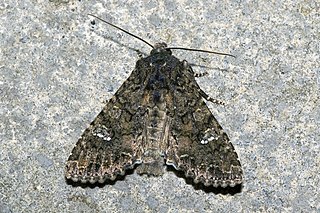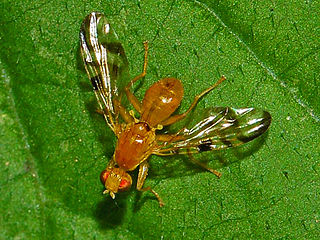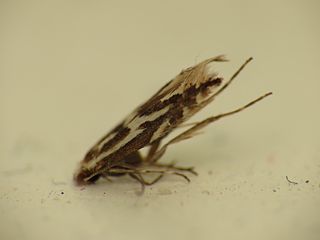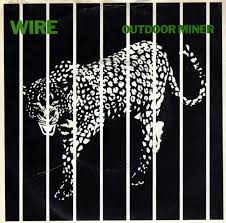
The cabbage moth is primarily known as a pest that is responsible for severe crop damage of a wide variety of plant species. The common name, cabbage moth, is a misnomer as the species feeds on many fruits, vegetables, and crops in the genus Brassica. Other notable host plants include tobacco, sunflower, and tomato, making this pest species particularly economically damaging.

A leaf miner is any one of numerous species of insects in which the larval stage lives in, and eats, the leaf tissue of plants. The vast majority of leaf-mining insects are moths (Lepidoptera), sawflies, and flies (Diptera), though some beetles also exhibit this behavior.

The Agromyzidae are a family commonly referred to as the leaf-miner flies, for the feeding habits of their larvae, most of which are leaf miners on various plants.

Gracillariidae is an important family of insects in the order Lepidoptera and the principal family of leaf miners that includes several economic, horticultural or recently invasive pest species such as the horse-chestnut leaf miner, Cameraria ohridella.
Birch leafminers are sawflies, which are closely related to bees and wasps. They are among the most common insect pests affecting Birch trees in North America. Areas inside the leaves are consumed by the larvae, affecting the leaves' ability to produce food. Yearly browning of birch leaves are noticed in mid July and August, but the leafminers have been feeding inside the leaf tissue since early spring.

Caloptilia azaleella is a moth of the family Gracillariidae. It is endemic to Japan, but has been introduced worldwide, wherever there are Azaleas.

Acidia cognata is a species of fly in the family Tephritidae.

Pegomya hyoscyami, the beet leafminer or spinach leafminer, is a grey fly about 6 millimetres (0.24 in) long. It emerges in April–May and lays eggs on the undersides of leaves of beet, spinach, chard, and other greens. Eggs develop into larvae that burrow into the leaf hollowing out large patches of the leaf between leaf surfaces, often killing large parts of the leaf.

The spotted tentiform leafminer is a moth of the family Gracillariidae. It is known from all of Europe, east to Ukraine and central Anatolia. It is also known throughout North America including Nova Scotia, Quebec, Ontario, Wisconsin and California.
Eucosmophora ingae is a moth of the family Gracillariidae. It is known from Costa Rica.

Phyllocnistis perseafolia is a moth of the family Gracillariidae. It is known only from the type locality in the Department of Caldas, west-central Colombia, but probably widespread over northern South America wherever avocado is cultivated.

Asclepias sullivantii is a species of flowering plant in the milkweed genus, Asclepias. Common names include prairie milkweed, Sullivant's milkweed, and smooth milkweed. It is native to North America, where it occurs in the central United States and Ontario in Canada.
Liriomyza eupatoriella is a species of leaf miners, the larva of a fly in the family Agromyzidae. The larva of this species mines the leaves of plants of the genus Eupatorium, commonly called "boneset", as well as related plants of other genera, including white snakeroot.

The yellow-poplar weevil, scientific classification Odontopus calceatus, is a type of weevil which occurs in much of the eastern and southeastern United States. Its range is as far north as Massachusetts all the way south to the Gulf of Mexico, and from the Atlantic westward to the Mississippi River. It is also known as the sassafras mining weevil, tuliptree leafminer, tulip tree weevil, or the magnolia leaf miner.

"Outdoor Miner" is a song written by Colin Newman and Graham Lewis, and performed by the English post-punk band Wire. It was released in January 1979 as the band's fourth single and appeared on their second album, Chairs Missing.
Liriomyza sativae, commonly known as the vegetable leaf miner, is a species of insect, a fly in the family Agromyzidae. The larvae of this fly mine the leaves of a range of vegetables and weeds, but seem to favour plants in the families Cucurbitaceae, Fabaceae and Solanaceae.
Liriomyza huidobrensis, commonly known as the pea leaf miner, is a species of insect, a fly in the family Agromyzidae. The larvae of this fly mine the leaves and stems of peas and a range of other vegetables. It is also known as the serpentine leaf miner, but this name is also used for a closely related species, Liriomyza brassicae.
Liriomyza trifolii, known generally as the American serpentine leafminer or celery leafminer, is a species of leaf miner fly in the family Agromyzidae.

Alternaria leaf spot or Alternaria leaf blight are a group of fungal diseases in plants, that have a variety of hosts. The diseases infects common garden plants, such as cabbage, and are caused by several closely related species of fungi. Some of these fungal species target specific plants, while others have been known to target plant families. One commercially relevant plant genus that can be affected by Alternaria Leaf Spot is Brassica, as the cosmetic issues caused by symptomatic lesions can lead to rejection of crops by distributors and buyers. When certain crops such as cauliflower and broccoli are infected, the heads deteriorate and there is a complete loss of marketability. Secondary soft-rotting organisms can infect stored cabbage that has been affected by Alternaria Leaf Spot by entering through symptomatic lesions. Alternaria Leaf Spot diseases that affect Brassica species are caused by the pathogens Alternaria brassicae and Alternaria brassicicola.













